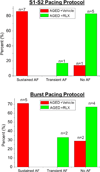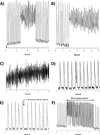Relaxin suppresses atrial fibrillation in aged rats by reversing fibrosis and upregulating Na+ channels
- PMID: 26711798
- PMCID: PMC4801709
- DOI: 10.1016/j.hrthm.2015.12.030
Relaxin suppresses atrial fibrillation in aged rats by reversing fibrosis and upregulating Na+ channels
Abstract
Background: Atrial fibrillation (AF) contributes significantly to morbidity and mortality in elderly patients and has been correlated with enhanced age-dependent atrial fibrosis. Reversal of atrial fibrosis has been proposed as therapeutic strategy to suppress AF.
Objective: To test the ability of relaxin to reverse age-dependent atrial fibrosis and suppress AF.
Methods: Aged F-344 rats (24 months old) were treated with subcutaneous infusion of vehicle or relaxin (0.4 mg/kg/day) for 2 weeks. Rat hearts were excised, perfused on a Langendorff apparatus, and stained with voltage and Ca(2+) indicator dyes. Optical mapping and programmed electrical stimulation was used to test arrhythmia vulnerability and changes in electrophysiological characteristics. Changes in protein expression and Na(+) current density (INa) were measured by tissue immunofluorescence and whole-cell patch clamp technique.
Results: In aged rats, sustained AF was readily induced with a premature pulse (n = 7/8) and relaxin treatment suppressed sustained AF by a premature impulse or burst pacing (n = 1/6) (P < .01). Relaxin significantly increased atrial action potential conduction velocity and decreased atrial fibrosis. Relaxin treatment increased Nav1.5 expression (n = 6; 36% ± 10%) and decreased total collagen and collagen I (n = 5-6; 55%-66% ± 15%) in aged atria (P < .05) and decreased collagen I and III and TGF-β1 mRNA (P < .05). Voltage-clamp experiments demonstrated that relaxin treatment (100 nM for 2 days) increased atrial INa by 46% ± 4% (n = 12-13/group, P < .02).
Conclusion: Relaxin suppresses AF through an increase in atrial conduction velocity by decreasing atrial fibrosis and increasing INa. These data provide compelling evidence that relaxin may serve as an effective therapy to manage AF in geriatric patients by reversing fibrosis and modulating cardiac ionic currents.
Keywords: Aging; Atrial fibrillation; Fibrosis; Relaxin; Sodium channel.
Copyright © 2016 Heart Rhythm Society. Published by Elsevier Inc. All rights reserved.
Conflict of interest statement
Figures







References
-
- Lip GY, Brechin CM, Lane DA. The global burden of atrial fibrillation and stroke: A systematic review of the epidemiology of atrial fibrillation in regions outside north america and europe. Chest. 2012;142:1489–1498. - PubMed
-
- Kannel WB, Wolf PA, Benjamin EJ, Levy D. Prevalence, incidence, prognosis, and predisposing conditions for atrial fibrillation: Population-based estimates. Am J Cardiol. 1998;82:2N–9N. - PubMed
-
- Benjamin EJ, Wolf PA, D'Agostino RB, Silbershatz H, Kannel WB, Levy D. Impact of atrial fibrillation on the risk of death: The framingham heart study. Circulation. 1998;98:946–952. - PubMed
-
- Lau YF, Yiu KH, Siu CW, Tse HF. Hypertension and atrial fibrillation: Epidemiology, pathophysiology and therapeutic implications. J Hum Hypertens. 2012;26:563–569. - PubMed
Publication types
MeSH terms
Substances
Grants and funding
LinkOut - more resources
Full Text Sources
Other Literature Sources
Medical
Miscellaneous

